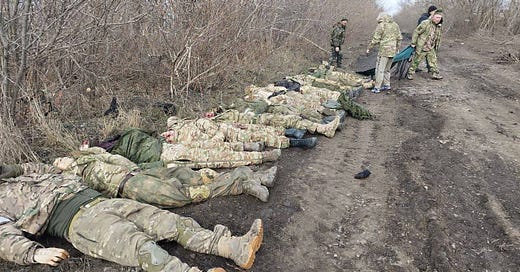This weekend, the Russian force in Ukraine may have suffered its bloodiest day. And it’s apparent why. The Russians have opened a new front in their 27-month wider war, adding a northern offensive—or feint, perhaps—to their offensives in the east.
More Russian infantry are attacking. But with Russian industry struggling to manufacture new weapons—or restore older weapons—in adequate numbers, there aren’t more armored vehicles to support them.
The Ukrainian defense ministry reported a staggering 1,740 Russian combat losses on Sunday. “It's the highest daily number since Feb. 24, 2022,” the ministry noted.
The 1,700 new casualties bring to 484,030 the total number of Russian troop losses the ministry in Kyiv has counted since the start of the wider war. That number exceeds, by tens of thousands, the strength of the initial Russian invasion force. Meaning, in essence, Ukraine has wiped out nearly the entire pre-war Russian army.
It’s possible Ukraine has over-estimated Russian casualties. But that mostly depends on how the Ukrainian defense ministry defines a “loss.” It’s probably a stretch to claim to that Russia has suffered 484,030 fatalities in the wider war. But independent counts align with Russia suffering nearly half a million total casualties—killed and badly wounded—in 27 months.
Why the casualty rate has spiked is obvious. “As the active front line expands, so do casualties,” Astraia Intel noted. Over the weekend, a new grouping of Russian forces advanced into a chain of villages in the lightly-defended “gray zone” along the Russia-Ukraine border just 20 miles north of Kharkiv, Ukraine’s second city.
So now Russian forces are attacking in several main sectors: west of Avdiivka and outside Chasiv Yar in the east as well as north of Kharkiv. If you believe Ukraine’s official tally, the Russians were, on average, losing a thousand troops or so every day before they attacked in the north. The Kharkiv effort has nearly doubled their losses.
A growing shortage of armored vehicles may be contributing to Russia’s deepening losses. As losses of purpose-made combat vehicles exceeded 15,000 this spring and production of new vehicles continued to lag, more Russian regiments began riding into battle in civilian-style vehicles including open-top golf carts—and even on motorbikes. These vehicles are extremely vulnerable to drones and artillery.
“The enemy has lost the ability to maneuver, and their losses are sharply increasing,” the Ukrainian Center for Defense Strategies explained. Which is not to say the Russians can’t continue to attack and advance. But they attack without protection and advance only short distances—and at staggering cost.
The question that no one can answer, and which could decide the outcome of the wider war, is how long Russia—a country of 144 million facing some profound demographic challenges—can sustain the killing or maiming of up to 1,700 people per day from relatively narrow population bands: young and middle-age men.
Read more:
The United States Has Given Ukraine a Hundred M-2 Bradley Fighting Vehicles in Just Two Weeks
In two weeks, the United States has shipped around 100 M-2 Bradley infantry fighting vehicles to Ukraine. That’s a lot of Bradleys: enough to replace all the 33-ton, 10-person M-2s the Ukrainian army’s 47th Mechanized Brigade—so far Ukraine’s only Bradley-operator—has lost in a year of non-stop combat in southern and eastern …






